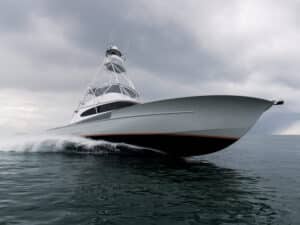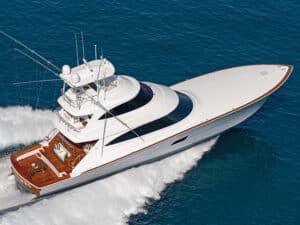Fishing Day 1 of the Pirate’s Cove Billfish Tournament in August, the 58 proved Don Blount’s hull design a success; the boat easily qualified as the most stable of any that Davis has built – and that’s saying something.
Blount designed the hull to keep the famous Davis head-sea ability, while increasing both stability and fuel efficiency. Blount has done a fine job of it. It works.
The 58’s bow sports more flare than her 61-foot predecessor, and is also fuller amidships. Interestingly, both the 58- and 61-footers have the same entry forward. The new 58 has close to the same displacement as the 61 too. But there the similarities end.
The 58 has a dramatically different bottom. Carrying a 17-degree vee at the transom, the 58’s chine to keel area now carries about 2^ inches of belly that runs all the way forward. According to Blount, this improves acceleration, increases stability and makes for a drier ride.
Fishability
A spread of natural baits proved easily visible, thanks to a smooth wake with little white water at a trolling speed of 7 knots, running with only one engine. Even more important, perhaps, is that no matter what the wind’s direction or speed you run, there’s absolutely no blow-back of exhaust or spray into the cockpit.
Whether drifting or trolling in a beam sea, the Davis 58 was dock-like in its stability. Running down sea has no effect on handling. The bow rises without any swerving or engine lag. With the fine entry, it should do much the same in larger seas.
Flybridge
Most trips offshore find numerous people sleeping on the flybridge. The settees forward of the helm – large enough to seat at least a dozen guests – provide full-length nap locations.
The classic, varnished teak helm pod is raised for clear visibility both fore and aft. All electronics and controls are laid out well, though I prefer mechanical aircraft tachs to Caterpillar’s LCD engine display.
Our test boat had a flybridge ladder through a hatch because that’s what the owner wanted. I prefer the indentation in the overhang that Davis usually uses to mount the ladder.
Engine Room
I usually have trouble with the engine room on sport-fishing boats under 65 feet because I’m pretty large. The Davis 58 accommodates me surprisingly well with a wider walkway between engines, and I could almost stand up straight. I even had room to climb outboard of both engines, so all routine maintenance should be a cinch to accomplish.
The engine-room systems have been regionalized. You’ll find the twin generators on the aft bulkhead, most of the plumbing to port, the air conditioning and water makers on the forward bulkhead and the wiring to starboard.
Under way, the twin V-12 Caterpillar 3412s, rated at 1,300 hp each, seemed unusually quiet – even though this boat has no more soundproofing than others – except for the particularly noticeable noise of the turbo whistle.
Cockpit
A Davis 58 owner can dictate how the cockpit should be laid out regarding size and placement of fish boxes, bait wells and the like. The cockpit’s forward bulkhead offers all the fishing amenities you’d expect and one more. The Davis has the most expansive sun shade/overhang I’ve ever seen on this size boat.
Interior
This 58 had a unique maple interior. Unlike a pale ash interior, the tan maple with a stronger hint of grain lends more character to the living quarters while still adding light.
One of the most innovative aspects of the interior are the Sub-Zero refrigerators – all in drawers. That’s right. Six large, deep drawers serve as refrigerators and/or freezers, depending on the temperature at which you individually set them. It makes storing things much easier, and you’ll never worry about the contents spilling out onto the floor again.
Construction
Buddy Davis makes a tough boat. Each boat features a solid bottom, Divinycell topsides, cabin and bridge, and Baltek coring in the decks. The laminate contains isophthalic and orthophthalic resins throughout, except for a skin-coat of vinylester resin and two layers of epoxy, to prevent any osmotic blistering problems.
One trend that Buddy has bucked: He’s gone against the current “wisdom” of making the entire foredeck a high-gloss surface and instead has opted for all nonskid. He hasn’t bowed to pressure for a bow rail yet, though, so the aesthetics haven’t been compromised.







